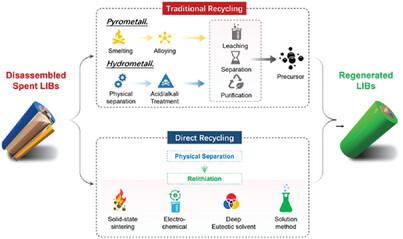当前位置:
X-MOL 学术
›
Adv. Mater.
›
论文详情
Our official English website, www.x-mol.net, welcomes your feedback! (Note: you will need to create a separate account there.)
Degradation Mechanisms of Electrodes Promotes Direct Regeneration of Spent Li-Ion Batteries: A Review
Advanced Materials ( IF 29.4 ) Pub Date : 2024-03-27 , DOI: 10.1002/adma.202313273 Kai Jia 1 , Guorui Yang 1 , Yujia He 1 , Zhenjiang Cao 1 , Juntao Gao 1 , Hongyang Zhao 1 , Zhihong Piao 2 , Junxiong Wang 1, 3 , Amr. M. Abdelkader 4 , Zheng Liang 3 , R. Vasant Kumar 5 , Guangmin Zhou 2 , Shujiang Ding 1 , Kai Xi 1
Advanced Materials ( IF 29.4 ) Pub Date : 2024-03-27 , DOI: 10.1002/adma.202313273 Kai Jia 1 , Guorui Yang 1 , Yujia He 1 , Zhenjiang Cao 1 , Juntao Gao 1 , Hongyang Zhao 1 , Zhihong Piao 2 , Junxiong Wang 1, 3 , Amr. M. Abdelkader 4 , Zheng Liang 3 , R. Vasant Kumar 5 , Guangmin Zhou 2 , Shujiang Ding 1 , Kai Xi 1
Affiliation

|
The rapid growth of electric vehicle use is expected to cause a significant environmental problem in the next few years due to the large number of spent lithium-ion batteries (LIBs). Recycling spent LIBs will not only alleviate the environmental problems but also address the challenge of limited natural resources shortages. While several hydro- and pyrometallurgical processes are developed for recycling different components of spent batteries, direct regeneration presents clear environmental, and economic advantages. The principle of the direct regeneration approach is restoring the electrochemical performance by healing the defective structure of the spent materials. Thus, the development of direct regeneration technology largely depends on the formation mechanism of defects in spent LIBs. This review systematically details the degradation mechanisms and types of defects found in diverse cathode materials, graphite anodes, and current collectors during the battery's lifecycle. Building on this understanding, principles and methodologies for directly rejuvenating materials within spent LIBs are outlined. Also the main challenges and solutions for the large-scale direct regeneration of spent LIBs are proposed. Furthermore, this review aims to pave the way for the direct regeneration of materials in discarded lithium-ion batteries by offering a theoretical foundation and practical guidance.
中文翻译:

电极的降解机制促进废旧锂离子电池的直接再生:综述
由于大量废旧锂离子电池(LIB),电动汽车使用的快速增长预计将在未来几年造成严重的环境问题。回收废锂离子电池不仅可以缓解环境问题,还可以解决有限自然资源短缺的挑战。虽然开发了几种湿法和火法冶金工艺来回收废电池的不同成分,但直接再生具有明显的环境和经济优势。直接再生方法的原理是通过修复废材料的缺陷结构来恢复电化学性能。因此,直接再生技术的发展很大程度上取决于废锂离子电池缺陷的形成机制。这篇综述系统地详细介绍了电池生命周期中各种正极材料、石墨负极和集流体的退化机制和缺陷类型。基于这种理解,概述了直接再生废锂离子电池中材料的原则和方法。还提出了大规模直接再生废锂离子电池的主要挑战和解决方案。此外,本综述旨在通过提供理论基础和实践指导,为废弃锂离子电池材料的直接再生铺平道路。
更新日期:2024-03-27
中文翻译:

电极的降解机制促进废旧锂离子电池的直接再生:综述
由于大量废旧锂离子电池(LIB),电动汽车使用的快速增长预计将在未来几年造成严重的环境问题。回收废锂离子电池不仅可以缓解环境问题,还可以解决有限自然资源短缺的挑战。虽然开发了几种湿法和火法冶金工艺来回收废电池的不同成分,但直接再生具有明显的环境和经济优势。直接再生方法的原理是通过修复废材料的缺陷结构来恢复电化学性能。因此,直接再生技术的发展很大程度上取决于废锂离子电池缺陷的形成机制。这篇综述系统地详细介绍了电池生命周期中各种正极材料、石墨负极和集流体的退化机制和缺陷类型。基于这种理解,概述了直接再生废锂离子电池中材料的原则和方法。还提出了大规模直接再生废锂离子电池的主要挑战和解决方案。此外,本综述旨在通过提供理论基础和实践指导,为废弃锂离子电池材料的直接再生铺平道路。



























 京公网安备 11010802027423号
京公网安备 11010802027423号